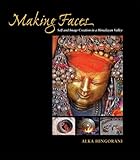Making Faces : Self and Image Creation in a Himalayan Valley / Alka Hingorani.
Material type: TextPublisher: Honolulu : University of Hawaii Press, [2012]Copyright date: ©2012Description: 1 online resource (160 p.) : 134 illus., 128 in colorContent type:
TextPublisher: Honolulu : University of Hawaii Press, [2012]Copyright date: ©2012Description: 1 online resource (160 p.) : 134 illus., 128 in colorContent type: - 9780824835255
- 9780824837242
- 731/.75095452 23
- N8195.I4 H46 2013
- online - DeGruyter
- Issued also in print.
| Item type | Current library | Call number | URL | Status | Notes | Barcode | |
|---|---|---|---|---|---|---|---|
 eBook
eBook
|
Biblioteca "Angelicum" Pont. Univ. S.Tommaso d'Aquino Nuvola online | online - DeGruyter (Browse shelf(Opens below)) | Online access | Not for loan (Accesso limitato) | Accesso per gli utenti autorizzati / Access for authorized users | (dgr)9780824837242 |
Frontmatter -- Contents -- Acknowledgments -- 1. Introduction -- 2. The Object -- 3. The Process -- 4. Speaking of Aesthetics -- 5. The Artisan -- Epilogue -- Notes -- Glossary -- Bibliography -- Index -- About the Author
restricted access online access with authorization star
http://purl.org/coar/access_right/c_16ec
Taberam Soni, Labh Singh, Amar Singh, and other artists live and work in the hill-villages of the lower Himalayas in Himachal Pradesh, India. There they fashion face-images of deities (mohras) out of thin sheets of precious metal. Commissioned by upper-caste patrons, the objects are cultural embodiments of divine and earthly kinship. As the artists make the images, they also cross caste boundaries in a part of India where such differences still determine rules of contact and correspondence, proximity and association. Once a mohra has been completed and consecrated, its maker is not permitted to touch it or enter the temple in which it is housed; yet during its creation the artist is sovereign, treated deferentially as he shares living quarters with the high-caste patrons.Making Faces tells the story of these god-makers, the gods they make, and the communities that participate in the creative process and its accompanying rituals. For the author, the process of learning about Himachal, its art and artists, the people who make their home there, involved pursuing itinerant artists across difficult mountainous terrain with few, if any, means of communication between the thinly populated, high-altitude villages. The harsh geography of the region permits scant travel, and the itinerant artisan forms a critical link to the world outside; villages that commission mohras are often populated by a small number of families. Alka Hingorani evokes this world in rich visual and descriptive detail as she explores the ways in which both object and artisan are received and their identities transformed during a period of artistic endeavor.Making Faces is an original and evocative account, superbly illustrated, of the various phases in the lifecycle of a mohra, at different times a religious icon, an art object, and a repository of material wealth in an otherwise subsistence economy. It will be welcomed by scholars and students of anthropology, material culture, religion, art history, and South Asian studies.
Issued also in print.
Mode of access: Internet via World Wide Web.
In English.
Description based on online resource; title from PDF title page (publisher's Web site, viewed 02. Mrz 2022)


